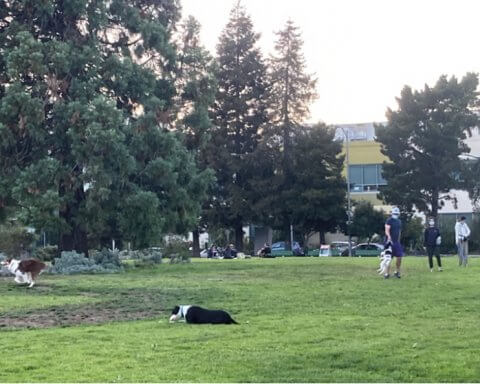A group of volunteers is cultivating a garden that consists of plants native to the area, adapted to the soil above Serpentinite bedrock that’s prevalent along Vermont and 17th streets. The plot is being nurtured through a collaboration between the Potrero Gateway Project (PGP), California Native Plant Society – Yerba Buena Chapter, landscape architecture firm Field Collective, and the Dogpatch and Northwest Potrero Hill Green Benefit District (GBD).
The garden’s name, Eco-Patch, reflects the geographic isolation caused by habitat fragmentation, which in turn reduces biodiversity. A network of patches in close proximity could renew the ecosystem, according to Field Collective Landscape Architect Alex Harker.
“The Eco-Patch encourages imitation as it seeks to show the positive impact a network of habitat patches can have on biodiversity,” she said.
The Eco-Patch is in its initial test phase. Eventually there’ll be a larger demonstration garden on the site. Volunteers from the California Native Plant Society, PGP steering committee, and GBD biodiversity committee are evaluating plants and weed management strategies.
“We’ve spent a lot of time determining what plants are the most likely to be well-suited for the site: low water use, adapted to or tolerant of serpentine soils, wind tolerant, high habitat value, seasonal color and interest – including taking into account what plants go dormant for part of the year,” Harker said. “Field Collective has worked closely with the California Native Plant Society and landscape architect Terri McFarland, who is also on the GBD board, to develop these plant lists.”
The plant list includes 45 different species, such as common yarrow, deerweed, sea thrift, California poppy, coast buckwheat, sky lupine, and hummingbird sage. The test garden will be used to determine which plants are most successful and should be incorporated into the demonstration patch.
“The idea is that we will develop and fine tune these planting lists so we can share them with the greater community and inspire people to plant their own ‘patches,’” Harker said.
Volunteers will continually monitor the plants and collect data on how well their thriving, seasonal changes, and maintenance needs, according to Harker and Jean Bogiages, Potrero Gateway Park Project steering committee chair and Eco-Patch volunteer team member. Eco-Patch visitors are encouraged to record their observations using the app iNaturalist.
In addition to analyzing the plants’ aesthetics, volunteers are testing three non-chemical weed management approaches: sheet mulching, sheet mulching with a “filler” species, and solarization.
Months ago, volunteers deposited compost, followed by cardboard, more compost, then mulch to suppress weeds as a means to establish the desired plants. Sheet mulching with a “filler” species consists of planting seeds with fast-growing grasses and other florae with the intention they’ll outcompete the weeds until other plants fill in, Harker said. All mulch is “green;” the entire planting area will eventually be blanketed by groundcover planting, which’ll suppress unwanted vegetation and increases plant biodiversity by layering multiple plants.
Soil solarization is a nonchemical method to control weeds through high temperatures. It captures radiant energy from the sun to “bake” the soil by covering it with two-millimeter thick, clear plastic for about six weeks.
“The Eco-Patch project wants to jumpstart planting of San Francisco native plants that provide a critical habitat for wildlife that have evolved with these particular plants by demonstrating how they can be used in a garden setting,” Bogiages said.
The Eco-Patch is part of the larger PGP Project, which focuses on transforming neglected open space in the Caltrans right-of-way between 17th, Mariposa, San Bruno, and Vermont streets. With San Francisco Department of Public Works’ help, the PGP Project steering committee wants to add art under the adjacent bridge, an upgraded bike lane and sidewalk expansion on 17th Street, corner curb extensions to enhance pedestrian safety, and a green wall/fence where needed to replace existing chain link on San Bruno Avenue.
The PGP Project first emerged in 2012, when Mariposa, Utah, 18th Street (MUNA) neighbors organized to beautify San Bruno Avenue and bolster the sound barrier along the 17th and Vermont streets Caltrans right-of-way. They formed the PGP Project steering committee and raised $15,000 to retain City-based landscape architect firm Bionic. With the firm’s help, the steering committee secured more funding from local businesses, the City, and state programs, which snowballed, with the help of Public Works, into $3 million to fund the project. Landscape and streetscape design responsibility is being managed by Public Works in collaboration with the PGP Steering committee.
Other PGP Project collaborators include real estate developers Trumark Rowan and Spear Street Capital.


